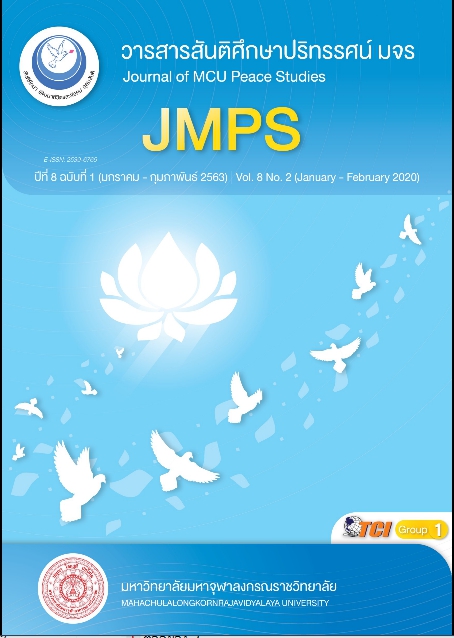Human Behaviors in Promoting Balance of Family according to Buddhist Psychology
Main Article Content
บทคัดย่อ
This paper presents the qualitative research which consists of two objectives, namely:- 1) To examine the concept of balance of family in Buddhism and the theory of family behavior in Psychology, and 2) To suggest human behaviors in promoting balance of Family according to Buddhist Psychology. The data were collected and analyzed together with the in-depth interviews were carried out with 7 key-informants. The findings show balance of family implies a group of persons who live together in relationships consisting either of spouse or parents and child. Family members adopt a similar pattern of Buddhist virtuous behavior existing in equal and mutually beneficial amounts that result in a happy, good and balance relationship. Firstly, a Spouse family without children both needs to have (1) qualities of the virtues for the laity (gharavāsadhamma), (2) equitable (samajīvidhamma), (3) endowing with self-responsibilities as suggested in the Sīgālovāda Sutta, as well as (4) living together as deity spouse instead of ghost. Secondly, Parents and Children should reciprocally share the common Buddhist practices, such as (1) filial piety (kataññūkataveditā), and (2) self-responsibilities as in Sīgālovāda Sutta. However, the theories in psychology described relationships, beliefs, behaviors and equilibrium of the family. In addition, the fivefold supportive behavior is a key to promote the sustainable balance of family according to Buddhist Psychology. They are: Emotional, Esteem, Social Network, Tangible, and Informational support.
Article Details
ทัศนะและความคิดเห็นที่ปรากฏในบทความในวารสาร ถือเป็นความรับผิดชอบของผู้เขียนบทความนั้น และไม่ถือเป็นทัศนะและความรับผิดชอบของกองบรรณาธิการ ยินยอมว่าบทความเป็นลิขสิทธิ์ของวารสาร
เอกสารอ้างอิง
Ajzen, I. (1991). “The Theory of Planned Behavior”, Organizational Behavior and Human Decision Processes. 50(2), 179-211.
Andersen, D. & Smith, H. (1913). Sutta-Nipāta. New Ed. London: Routledge & Kegan Paul.
Balswick, J. O. Balswick, J. K. (2014). The Family: A Christian Perspective on the Contemporary Home. 4th ed. Grand Rapids: Baker Academic.
Bodhi, Bhikkhu. (2000). Saṃyuttanikāya: The Connected Discourses of the Buddha. Vol 1. Oxford: PTS.
Bowen, M. (1978). Family Therapy in Clinical Practice. New York: Aronson.
Capra, F. (1988). The Turning Point: Science, society and the rising culture. New York: Bantam Book.
Collin, S. (2007). Dictionary of Science and Technology. 2nd ed. London: A&C Black Publishers Ltd.
Cutrona, C. E. & Russell, D. W. (1990). “Type of Social Support and Specific Stress: Toward a Theory of Optimal Matching”. In Sarason, B. R; Sarason, I. G; Pierce, G. R. (Eds.). Social Support: An Interactional View. New York: John Wiley, 319-366.
Cutrona, C. E. & Suhr, J. (1992). “Controllability of Stressful Events and Satisfaction with Spouse Support Behaviors”, Communication Research. 19(2), 154-174.
Cutrona, C. E. (1996). Social support in couples. Thousand Oaks. CA: Sage.
Cutrona, C. E. (1990). “Stress and Social Support: In Search of Optimal Matching”, Journal of Social and Clinical Psychology. 9(1), 3-14.
Davids, T.W. & Stede, W. (1925). The Pali Text Society’s Pali-English Dictionary. London: n.p.
Davids, T.W. & Stede, W. (1921). The Pali Text Society’s Pali-English Dictionary. London: PTS.
Davids, T.W. & Carpenter, J. (1975). The Dīgha Nikāya. Vol.I. London: PTS.
Davids, T.W. Carpenter, J. (1968). The Sumaṅgala-Vilāsinī, Buddhaghosa’s Commentary on the Dīgha Nikāya. Part I. 2nd ed. London: PTS.
Dawson, P. & Sturm, L. (2003). “Failure to Thrive, Loss, and Bereavement”, International Encyclopedia of Marriage and Family. ed. in Chief by Ponzetti, James J. Jr. 2nd ed., Vol. 2: Ea-Ju (4 Vol. Set). New York: Thomson Gale, 543-546.
Estlin, J. (1976). The Dīgha Nikā ya. Vol.III. London: PTS.
Feer, M. L. (1991). Saṃyutta-Nikāya. Part I. Sagāthana-Vagga. Oxford: PTS.
Fincham, F. D. & Beach, S. R. (2010). “Marriage in the new millennium: A decade in review”, Journal of Marriage and Family. 72(3), 630-649.
Hardy, E. (1976). The Aṅguttara- Nikāya. Part III. Pañcaka-Nipāta, and Chakka-Nipāta London: PTS.
Lawrence, E. et al. (2008). “Objective ratings of relationship skills across multiple domains as predictors of marital satisfaction trajectories”, Journal of social and personal relationships. 25(3), 445-466.
Law, B. C. (1926). “Marriage in the Buddhist Tradition”. Guild to Buddhism A To Z. Retrieved 9 January, 2020, from http://www.buddhisma2z.com/content.php?id=248.
Matsumoto, D. (2009). The Cambridge Dictionary of Psychology. New York: Cambridge University Press.
Melino, G. A Knight, R. and Claude A. J. (2010). “The Siren’s Song: This Death That Makes Life Live”, Cell Death: Encyclopedia of Life Sciences. eds. by Gerry Melino, David Vaux. Chichester: John Wiley & Sons Ltd, 1.
Morris, R. The Rev. (1961). The Aṅguttara- Nikāya. Part I. Ekanipāta, Dukanipāta, and Tikanipāta. 2nd ed. London: PTS.
Morris, R. The Rev. (1976). The Aṅguttara- Nikāya. Part II. Catukka Nipāta. London: PTS.
Oldenberg, H. (1997). The Vinaya Piṭakaṃ. Vol.I. The Mahāvagga. Oxford: PTS.
Parsons, T. (1991). The Social System. ed. By Bryan S. Turner. London: Routledge.
Prigogine, I. Stengers, I. (1984). Order out of Chaos. New York: Bantam.
Rogers, K. (2011a). The Human Body The Brain and the Nervous System. New York: Britannica Educational Publishing.
Rogers, K. (2011b). The Human Body The Digestive System. New York: Britannica Educational Publishing.
Sullivan, K. T; Pasch, L. A; Johnson, M. D; Bradbury, T. N. (2010). “Social support, problem-solving, and the longitudinal course of newlywed marriage”, Journal of personality and social psychology. 98(4), 631.
Walshe, M. (1987). Dīghanikāya: Thus Have I Heard: The Long Discourses of the Buddha. London: Wisdom Publications.
Woodward, F. L. (1979). The Book of the Gradual Sayings (Aṅguttaranikāya). Vol. I (Ones, Twos, Threes). London: PTS.
Woodward, F. L. (1982). The Book of the Gradual Sayings (Aṅguttaranikāya). Vol. II (The Book of the Fours). London and Boston: Routledge & Kegan Paul Ltd.


